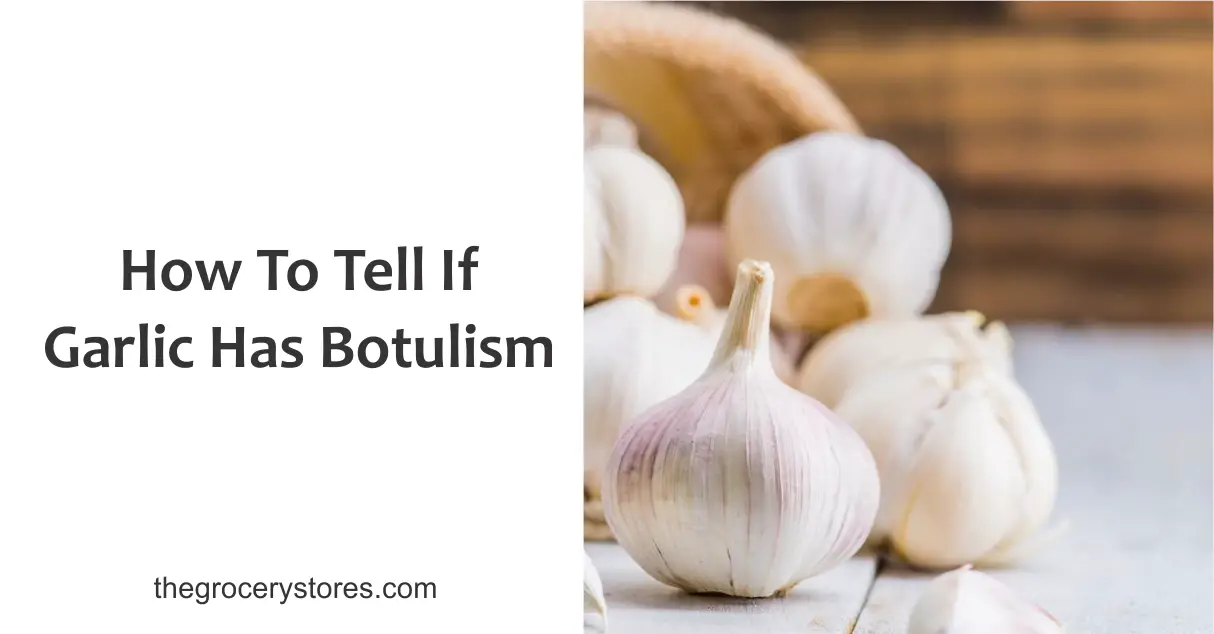Using garlic to cook does not only add flavor to the food; it also releases its special aroma into the food and air. However, in the same way you will be delighted with the results of using fresh garlic, you will not find it funny if you use rancid garlic or one that has botulism.
Since the outer covering of garlic has to be peeled before you dice and use it. You will notice bacterial spots and discoloration on the garlic that are affected by botulinum bacteria. You cannot detect it through the smell and gas it gives off.
Garlic should be discarded if the bulbs or cloves turn soft and mushy, turn yellow or brown, develop brown spots, or sprout green shoots. It is best to avoid taking a chance if you have bad garlic because it can be extremely dangerous and unhealthy.
What does botulism look like?
Botulism is a specific food-inhabiting bacterium that produces a toxin that causes a life-threatening muscle weakness disease. There are basically 7 forms of botulinum bacteria. They range from A to G. Human botulism types A, B, C, E, and F are the most common causes.
Because the bacteria as well as its toxin have no effect on flavor, they are particularly terrifying. As a result, if you weren’t aware that garlic-infused oil should be avoided, you might not notice anything was inappropriate until your eyesight started to become foggy and you had difficulty eating.
The only benefit of botulism is that it is picky. To survive, the bacteria require non-acidic, oxygen-free environments. Therefore, even though Clostridium botulinum spores are a natural component of our environment and undoubtedly present in some of our food, they don’t harm us because, as long as oxygen is present, they are locked down and aren’t releasing their signature toxins.
However, before you give up garlic or processed foods for good, understand that it is very easy to be poisoned by botulinum bacteria.
Does raw garlic contain botulism?
Garlic food poisoning is a possibility even if you don’t believe it’s harmful to your health. But inadequate home care for the root vegetable is more frequently to blame for garlic botulism.
Despite the strength of its flavor, garlic is a low-acid vegetable. A garlic clove typically has a pH of between 5.5 and 6.4 PPM, and like all low-acid vegetables, will encourage Clostridium botulinum growth and the subsequent release of its toxin under the right circumstances.
These issues include improper canning at home and inadequate preparation.
Does cooking garlic destroy botulism?
Botulism caused by food is a result of consuming processed foods that were improperly made. It is not common but can be very dangerous if diagnosis and treatments are not started quickly.
Cooking garlic is one effective way of getting rid of the toxins that make botulinum bacteria powerful. However, it must be done with maximum care at a degree of 190 Fahrenheit.
Because of the heat-resistant nature of Clostridium botulinum bacteria, it is known to be anaerobic. This means that it can grow and bloom only when oxygen is not present. So to get rid of it by cooking, you have to subject it to a very high temperature.
How long does garlic botulism take?
Botulism could develop in garlic preserved oil that is kept at room temperature.
Fresh garlic in oil should be prepared and kept in the fridge at 30°F or lower for no longer than seven days. It could stay frozen for a while. When packaging in plastic or glass freezer jars, leave a 1-inch space.
When you store garlic in oil and keep it in the refrigerator. Even with a low temperature, in just about 16 days, you will notice the botulinum bacteria growing. This happens when the temperature is not kept steady and constant.
Can botulism grow in the refrigerator?
Freshly and carefully preserved garlic will retain its quality when stored in a bottle and will last up to 2 years in a refrigerator. For any processed, bottled or canned food to stay for up to 2 years means good preservatives were used. Not just that, it was also kept at a constant temperature in the refrigerator.
After production, food can be preserved in a refrigerator. However, at a temperature of 10 degrees Celsius, botulism will be very lively and able to develop toxins within about 4 weeks of storage.
To minimize the chances of having botulism in your food, the refrigerator must always be kept at a steady temperature of about 4 degrees Celsius or even lower. If this temperature cannot be achieved, then the period of time the food will be stored should be reduced.
Why is my garlic in olive oil bubbling?
Botulism is a very prominent type of food poisoning. It is gotten from a bacteria known as Clostridium botulinum. Its growth can result in toxins being produced in the garlic, especially when stored in olive oil and kept at a high temperature.
The garlic you soaked in olive oil forms bubbles when it is not properly stored in a refrigerator. Bubbling is just its little way of showing you that it has possibly been contaminated. The best and safest option is to throw it away.
To minimize the possibility of getting infected by garlic botulism, preserve the cloves in oil and allow them to sit in a refrigerator for about 3 to 4 weeks. Any garlic soaked in oil and left at room temperature should not be eaten.
How long does it take for botulism to affect you?
Despite having a low acidity, garlic can produce toxic active spores if improperly stored. Experiencing dizziness, throwing up, lightheadedness, double vision, or having trouble breathing or swallowing are all signs of the botulism that garlic can cause. Consult your physician right away if you eat stale garlic and exhibit these side effects.
The Clostridium botulinum bacteria takes about 24 to 48 hours to begin to show its symptoms after consuming the food it has contaminated.
Once you are affected by this bacterial disease, your muscles become paralyzed because of the toxin it contains. If you ignore and treat the symptoms as minor, they will get worse and paralyze some muscles, like the ones located in your nose, arms, legs, and waist. Your body gets partially weak and unable to perform its duty.
Can you get botulism from jarred garlic?
It can be a real accomplishment some nights to prepare dinner at home and put it on the table. We understand that anything you can do to quickly go from being hungry to full is worthwhile, which is precisely why jarred minced garlic exists: to make life simpler.
Making cooking less stressful can be as simple as cutting out the extra minutes you might be spending on the peeling and chopping of garlic, which will still leave its pungent smell on your hands and chopping board.
Whenever there is oxygen present, these botulinum spores from soil are safe. However, when oil is applied to spore-containing garlic and it is sealed in a bottle, a space devoid of oxygen is produced that encourages the spores’ sprouting.
Although retail garlic in water or oil has probably been pasteurized, if it is stored incorrectly, it still has a chance of becoming botulism-infected. Even if it has been preserved with salts or acids, jarred mashed garlic should be kept in the refrigerator once it has been opened.
Jarred garlic has some drawbacks and trade-offs, though, that you should be aware of. Every shortcut has some drawbacks and trade-offs, after all. There are many reasons, in fact, why you’ll never see a jar of chopped garlic in a professional kitchen and why the majority of prestigious professional chefs will advise you to stick with the fresh vegetables.
Can fermented garlic have botulism?
Some forms of garlic can lead to an increased risk of botulism when improperly stored. When raw garlic is preserved in oil, the risk is especially high.
Low oxygen and low acid environments are ideal for the growth of Clostridium botulinum. Because garlic has little acid and home-made garlic oil has little oxygen, it poses a high risk of Clostridium botulinum for anyone, not just infants. Fermented garlic will most likely have botulinum.
Does salt prevent botulism?
Have you ever wondered what microscopic organisms eat? They lack conventional digestive systems, fangs, and beaks. The alternative is that they take up nutrients that are found in water.
You can use salt to prevent botulism in your meals. All you have to do is remove some of the water and add 10% salt. As much as you want your canned food to be botulinum free, make sure you do not add excess salt. Even though it will work, you are going to have a very hard time consuming your product.
Bacteria cannot grow or multiply without water because they need it to eat. The water activity of the food is used to calculate how much water is available to microbes. The main reason why using a dehydrator like salt gives you more preservative power is because it lowers this metric.

